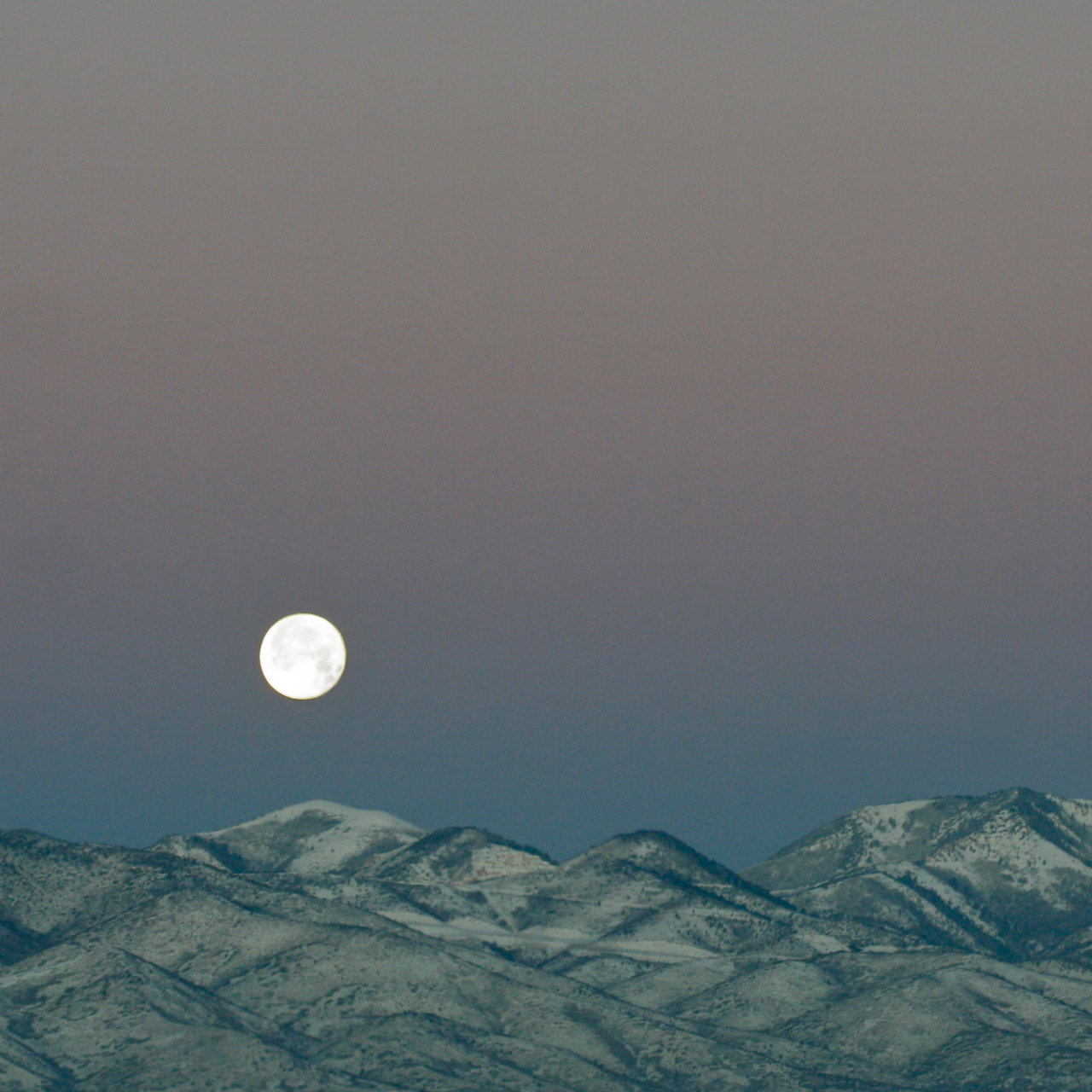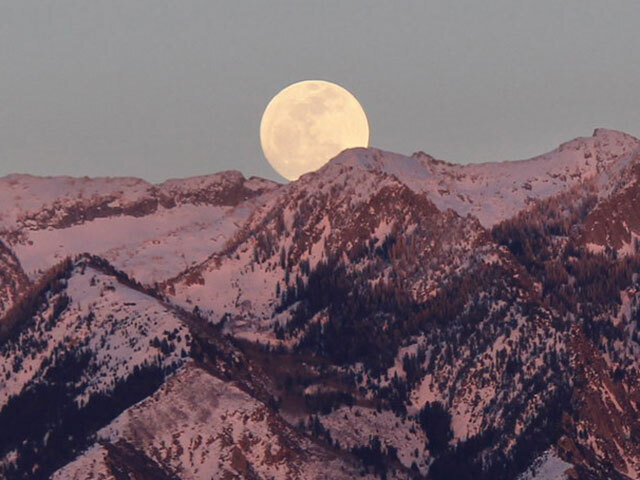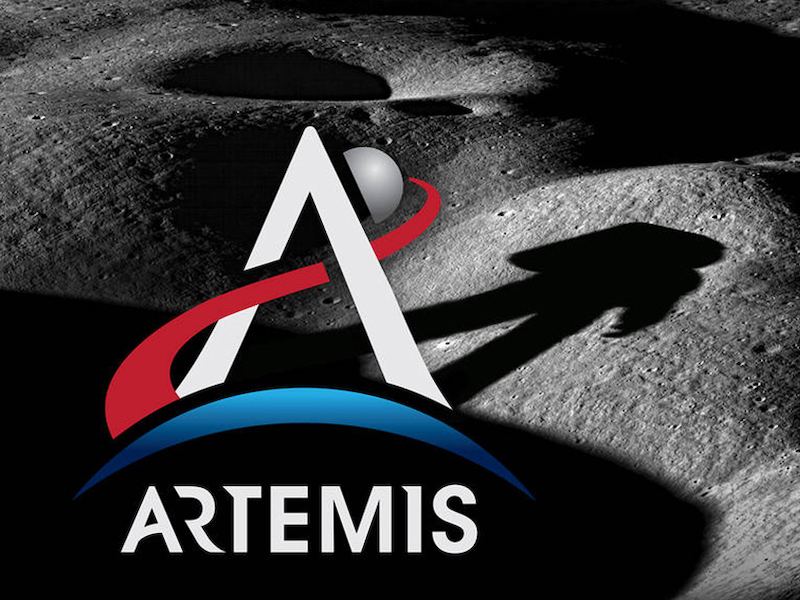News | February 27, 2018
Moon Missive: The Next Full Moon is the Worm Moon, Crow Moon, Crust Moon, Sap Moon, Sugar Moon, or Lenten Moon

Credit: NASA/Bill Dunford
The next full moon will be on Thursday evening, March 1, 2018, appearing "opposite" the Sun (in Earth-based longitude) at 7:51 PM EST. The Moon will appear full for about three days around this time, from Wednesday evening through Saturday morning.
As the last full moon of winter, this moon is called the Crow Moon, Crust Moon, Sap Moon, Sugar Moon, Worm Moon, or Lenten Moon. The Maine Farmer's Almanac first published "Indian" names for the full moons in the 1930's, and according to this almanac, the more northern tribes of the northeastern United States knew this as the Crow Moon, when the cawing of crows signaled the end of winter. Other northern names were the Crust Moon, because the snow cover becomes crusted from thawing by day and freezing by night, or the Sap (or Sugar) Moon as this is the time for tapping maple trees. More southern tribes called this the Worm Moon after the earthworm casts that appear as the ground thaws. It makes sense that only the southern tribes called this the Worm Moon. When glaciers covered the northern part of North America they wiped out the native earthworms. These glaciers melted about 12,000 years ago and the forests grew back without earthworms. The species of earthworms we have now in these areas are invasive species from Europe and Asia. The Europeans called this the Lenten Moon, as this moon corresponds with Lent, and the next moon, the first full moon in Spring, occurs just before Easter.
In lunisolar calendars the months change with the new moon and full moons fall in the middle of the lunar months. This full moon is in the middle of the month of Adar in the Hebrew calendar. The 14th day of Adar, corresponding with this full moon, is the holiday Purim. Purim commemorates the saving of the Jewish people in ancient Persia from a plot to have them all killed. The story is recorded in the Biblical Book of Esther. This full moon is the middle of the first month of the Chinese calendar. The 15th day of the first month is the Chinese Lantern Festival, the final day of the traditional Chinese New Year celebrations (see https://en.wikipedia.org/wiki/Lantern_Festival). As the full moon in the Hindu month of Falgun, this moon corresponds with the spring festival Holi, which among other things includes a free-for-all game involving the spraying of colored powders and/or colored water on whomever wanders by (see https://en.wikipedia.org/wiki/Holi). In the Islamic calendar the months start with the first sighting of the waxing crescent Moon a few days after the new moon. This full moon is near the middle of Jumada al-Thani, the sixth month of the calendar.
As usual, the wearing of suitably celebratory celestial attire is encouraged in honor of the full moon.
As for other celestial events between now and the full moon after next:
As winter ends and spring begins, the daily periods of sunlight will be lengthening at their fastest for the year. On the day of the full moon on Thursday, March 1, 2018, morning twilight will begin at 5:43 AM, sunrise will be at 6:40 AM, the Sun will reach a maximum altitude of 43.7 degrees at 12:21 PM, sunset will be at 6:01 PM, and evening twilight will end at 6:59 PM EST. We "spring forward" into daylight savings time on Sunday, March 11, 2018, giving us an "extra" hour of sunlight in the evening but shifting the time of sunrise back to within a few minutes of when sunrise was in late December and early January. These are not the latest sunrises of the year. The latest sunrises come in late October and early November, just before we "fall back" to standard time. By the day of the full moon after next, Saturday, March 31, 2018, morning twilight will begin at 5:56 AM, sunrise will be at 6:54 AM, the Sun will reach a maximum altitude of 55.4 degrees at 1:12 PM, sunset will be at 7:31 PM, and evening twilight will end at 8:29 PM EDT.
On the evening of the full moon on March 1, 2018, as evening twilight ends, the bright stars of the local arm of our home galaxy, including the constellation Orion, will appear spread across the sky from the south-southeast to the northwest. The planets Venus and Mercury will have emerged from the glow of the Sun to appear low in the west, with Mercury setting about 7 minutes before evening twilight ends, and Venus setting about 9 minutes later. Mercury and Venus will appear at their closest together on March 3, and Mercury will appear at its greatest angular separation from the Sun on March 15, after which Venus will continue to appear higher above the horizon, while Mercury will begin to shift back towards the setting Sun.
On the morning of March 1, 2018, as morning twilight begins, the planets Jupiter, Mars, and Saturn, along with the bright star Antares, will appear spread out in the south. For the Washington, DC area, Jupiter will appear farthest to the right in the southwest at about 34 degrees above the horizon, Mars will appear in the south-southwest at about 33 degrees elevation above the horizon, Antares will appear in the south at 26 degrees elevation, Mars in the south-southeast at 26 degrees above the horizon, and Saturn in the southeast at 21 degrees above the horizon. The Moon shifts about 12 degrees in the sky each night. Over the course of the week from March 4 to March 11, the Moon will shift along this line of stars an planets, appearing near the bright star Spica on March 4, between Spica and Jupiter on March 5, near Jupiter on March 7, between Mars and Jupiter, and above the bright star Antares on March 8, near Mars on March 9, between Mars and Saturn on March 10, and near Saturn on March 11. As the month progresses, Jupiter and Saturn will appear to shift towards the west, while Mars will appear to hover in place, so that by the morning of the full moon at the end of March, Saturn and Mars will appear together in the south-southeast.
Even though they are not visible usually, I include in these Moon missives information about Near Earth Objects (mostly asteroids) that pass the Earth within about 10 lunar distances, because I find it interesting that we have discovered so many. On Tuesday morning, February 27, 2018, at 5:57 AM EST (2018-Feb-27 10:57 UTC), Near Earth Object (2018 CU14), between 8 and 18 meters (26 to 59 feet) in diameter, will pass the Earth at between 5.4 and 5.5 lunar distances (nominally 5.4), traveling at 4.40 kilometers per second (9,842 miles per hour).
Tuesday morning, February 27, 2018, at 9:40 AM EST, the Moon will be at perigee, its closest to the Earth for this orbit. At 363,933 km (226,137 miles), the Moon will appear 11% larger in diameter than when it will be at apogee later in March.
On Wednesday, February 28, into Thursday morning, March 1, 2018, the bright star Regulus will appear near the nearly full Moon. For the Washington, DC area, evening twilight ends at 6:57 PM EST, they will appear at their closest around 1 AM on Thursday morning, after which the Moon and Regulus will appear to move apart until Regulus is lost in the glow of dawn, with morning twilight beginning at 5:43 AM EST.
As mentioned above, the next full moon will be on Thursday, March 1, 2018, at 7:51 PM EST. Festivals and events associated with the full moon include Purim, the Chinese Lantern Festival, and Holi.
Saturday midday, March 3, 2018, at 11:58 AM EST (2018-Mar-03 16:58 UTC), Near Earth Object (2018 DC), between 31 and 68 meters (100 to 224 feet) in diameter, will pass the Earth at between 9.2 and 9.3 lunar distances (nominally 9.3), traveling at 8.23 kilometers per second (18,415 miles per hour).
Saturday evening, March 3, 2018, if you have a clear view of the western horizon, you might be able to catch a glimpse of the planet Mercury about one degree to the right of the bright planet Venus. You will probably need to wait until about a half hour after sunset for the sky to be dark enough to see Venus, but don't wait too long, as they will set about an hour after sunset. One degree is about the width of the tip of your pinky finger held out at arm's length.
Sunday night, March 4, into Monday morning, March 5, 2018, the bright star Spica will appear about 8 degrees to the lower right of the waning gibbous Moon. For the Washington, DC area, the Moon will rise in the east at 9:08 PM, Spica will rise at 9:17 PM, the Moon will reach its highest in the sky for the night on Monday morning at 3:04 AM, and morning twilight will begin at 5:37 AM EST.
On Tuesday night, March 6, 2018, into Wednesday morning, March 7, 2018, the bright planet Jupiter will appear to the lower right of the waning gibbous Moon. For the Washington, DC area, the Moon will rise in the east-southeast at 11:11 PM, Jupiter will rise at 11:29 PM, the Moon will reach its highest in the sky for the night Wednesday morning at 4:38 AM, and morning twilight will begin at 5:34 AM EST.
On Wednesday morning, March 7, 2018, at 2:53 AM EST (2018-Mar-07 07:53 UTC), Near Earth Object (2017 VR12), between 211 and 472 meters (693 to 1,549 feet) in diameter, will pass the Earth at 3.8 lunar distances, traveling at 6.30 kilometers per second (14,092 miles per hour).
Friday morning, March 9, 2018, the waning Moon will appear half-full as it reaches its last quarter at 6:20 AM EST. The planet Mars will appear near the half-full Moon. For the Washington, DC area, the Moon will rise in the east-southeast at 1:05 AM, Mars will rise at 1:57 AM, and morning twilight will begin at 5:31 AM EST.
Sometime on Friday, March 9, or Saturday, March 10, 2018, (2018-Mar-10 05:10 UTC with about a day of uncertainty), Near Earth Object (2015 DK200), between 20 and 45 meters (66 to 148 feet) in diameter, will pass the Earth at between 5.7 and 13.4 lunar distances (nominally 6.9), traveling at 8.03 kilometers per second (17,964 miles per hour).
Saturday morning, March 10, 2018, the waning crescent Moon will appear between the planets Mars and Saturn. For the Washington, DC area, Mars will rise in the east-southeast at 1:55 AM, the Moon will rise 3 minutes later at 1:58 AM, Saturn will rise at 2:45 AM, and morning twilight will begin at 5:30 AM EST.
Don't forget to "Spring Forward" as we begin Daylight Savings Time on Sunday morning, March 11, 2018. As reported on Car Talk, in the USA, 2 to 3 AM local time on the morning when daylight savings starts tends to be the safest hour on record, with no accidents reported (except in Hawaii, American Samoa, Guam, the Northern Mariana Islands, Puerto Rico, the United States Virgin Islands, and the non-Navajo regions of Arizona).
Sunday morning, the Moon will appear near the planet Saturn. For the Washington, DC area, Saturn will rise in the east-southeast at 3:41 AM, the Moon will rise 6 minutes later at 3:47 AM. At 5:13 AM EDT, the Moon will be at apogee, at 404,682 km (251,458 miles) its farthest from the Earth for this orbit. Morning twilight will begin at 6:28 AM EDT (note the change to Daylight Savings Time).
Thursday, March 15, 2018, at around 11 AM EDT, the planet Mercury will be at its greatest angular separation from the Sun as seen from the Earth (18.4 degrees), called greatest eastern elongation, appearing half full in the evening sky when viewed by telescope. For Washington, DC and similar latitudes, at least, Thursday evening will be when the planet Mercury will appear at its highest above the western horizon after sunset, with the bright planet Venus to the lower left. Mercury should begin to be visible about a half hour after sunset, and Mercury should still be about 6 degrees above the horizon when evening twilight ends. For the Washington, DC area, a half hour after sunset will be at 7:45 PM, evening twilight will end at 8:13 PM EDT, Venus will set at 8:31 PM, and Mercury will set at 8:48 PM.
Saturday morning, March 17, 2018, at 9:12 AM EDT, will be the new moon, when the Moon passes between the Earth and the Sun and will not be visible from the Earth. The day of or the day after the new moon marks the start of the new month for most lunisolar calendars. The month of Nisan, the first month of the Hebrew calendar, starts at sundown on Friday, March 16, 2018. The second month of the Chinese calendar starts at midnight on March 17, 2018.
The day after the new moon, Sunday, March 18, 2018, marks the start of the new year in the Hindu calendar, with new year celebrations such as Gudi Padwa (see https://en.wikipedia.org/wiki/Gudi_Padwa) and Ugadi (see https://en.wikipedia.org/wiki/Ugadi).
In the Islamic calendar the months start with the first sighting of the waxing crescent moon a few days after the new moon. Saturday or Sunday evening, March 17 or 18, 2018, will mark the beginning of Rajab, the seventh month. Rajab is one of the four sacred months in which warfare and fighting are forbidden.
Sunday evening, March 18, 2018, if you have a clear view of the western horizon just after sunset, and perhaps with the aid of binoculars, you should be able to see the thin, waxing crescent Moon, the bright planet Venus, and the planet Mercury, lined up from left to right along the horizon. This is the season when the waxing crescent Moon appears most like an upward-facing bowl or a smile in the evening sky. This is called a "Wet Moon" or a "Cheshire Moon." According to Wikipedia, the term "Wet Moon" originates from Hawaiian mythology, when the Moon appears like a bowl that could fill up with water. The period when this occurs roughly corresponds with Kaelo the Water Bearer in Hawaiian astrology. As the year passes into summer, the crescent shape tilts, pouring out the water and causing the summer rains. The term "Cheshire moon" is a reference to the smile of the Cheshire Cat of Lewis Carroll's story Alice's Adventures in Wonderland.
Tuesday midday, March 20, 2018, at 12:15 PM EDT, will be the Vernal Equinox, the astronomical start of Spring.
On Thursday evening, March 22, 2018, the bright star Aldebaran will appear less than one lunar diameter below the waxing crescent Moon. For the Washington, DC area, they will appear near their closest when evening twilight ends at 8:20 PM, and will appear to separate until Aldebaran sets on Friday morning at 12:40 AM EDT, with the Moon setting 17 minutes later.
On Saturday midday, March 24, 2018, the Moon will appear half-full as it reaches its first quarter at 11:35 AM EDT.
Monday afternoon, March 26, 2018, at 1:17 PM EDT, the Moon will be at perigee, its closest to the Earth for this orbit. At 369,106 km (229,352 miles), the Moon will appear 10% larger in diameter than when when it will be at apogee earlier in March.
On Sometime on Tuesday, March 27, 2018 (2018-Mar-27 13:01 UTC with 8 hours 27 minutes uncertainty), Near Earth Object (2018 DH1), between 160 and 358 meters (525 to 1,175 feet) in diameter, will pass the Earth at between 8.7 and 9.6 lunar distances (nominally 9.1), traveling at 14.26 kilometers per second (31,901 miles per hour).
On Tuesday evening, March 27, into Wednesday morning, March 28, 2018, the bright star Regulus will appear near the waxing gibbous Moon. For the Washington, DC area, they will be about 8 degrees apart when evening twilight ends Tuesday at 8:25 PM, and will appear to shift closer together until the Moon sets at 5:28 AM EDT. The next evening, Wednesday, March 28, 2018, the Moon will appear to have shifted to the far side of Regulus, and will appear to move away as the evening progresses.
The full moon after next will be on Saturday, March 31, 2018, at 8:37 AM EDT. Since the 1940s the term "blue moon" has been used for the second full moon in a month (this appears to have started from a misunderstanding of the earlier meaning of blue moon). By this relatively new definition, 2018 is unusual for having two blue moons; we had two full moons in January, no full moon in February, and will have two full moons in March. The last time this happened (in Universal Time, which is what most commercial calendars use) was in 1999, and the next time it will happen will be in 2037. Note that sometimes the full moon falls close enough to midnight in Universal Time to be in a different month in your time zone, so whether and when we have a two full moons in a month or a February without a full moon can depend upon where you are.






